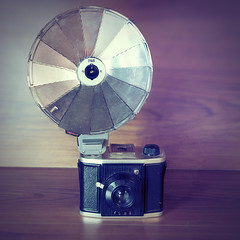Ponix
The Ponix (ポニックス) is a series of inexpensive 6×6 viewfinder cameras made in Japan from 1954 to 1959.[1] They were distributed by Chūō Shashin-yōhin and made by an unknown company, perhaps Daitoh Optical Co.
Contents
Description
The Ponix has a plastic body with metal top and bottom plates. The advance knob, made from moulded plastic, is on the top left[2] and the tubular viewfinder is above the middle of the top plate. There is a single uncovered red window in the middle of the back, to control the film advance. To load the film, the top plate is removable together with the exposure chamber and spool holders. There are strap lugs at both ends of the body.
The lens is a fixed focus 65/10 meniscus and the exposure chamber is curved to compensate the aberrations. The lens barrel is molded PONIX at the top, MADE IN JAPAN and something else at the bottom. The shutter release is to the side of the lens. There is a speed selector at the bottom.
Original model
The original Ponix has an accessory shoe on the top right and a PC synch post attached to the front of the body. It was advertised in November 1954[3] and October 1955[4] for ¥1,800, the case being sold for ¥500 extra. Only three speeds were mentioned: B, 1/25 and 1/50. In the latter advertisements, the camera was touted as "taking as good pictures as cameras costing ¥10,000" and "ideal for people tired of Bolta size cameras, for photography beginners and for former Vest Pocket users".
In December 1956, the camera was advertised for the same price.[5] The advertisement mentioned three speed settings: B, 1/25, 1/50 and 1/100, flash synchronization and lens coating. On the actual examples observed, the speed selector has B, 25, 50 and 100 positions.
Ponix Junior and Master
The Ponix Junior or Ponix JR (ポニックスJR型) has no accessory shoe, no flash synchronization and no tripod socket.[6] The speed settings are now B, F (Fast), M (Medium) and S (Slow). It was offered for ¥1,000 in October 1957.[7] The Ponix Junior normally has a short strap and a PONIX lens cap attached to one of the strap lugs by a small cord.
The original Ponix became the Ponix Master after the introduction of the Junior model.[8]
Ponix camera kit
The Ponix was sold in 1958 and 1959[9] as a kit called Ponix assembly set (ポニックス組立セット), obviously targeted to children. An advertisement dated February 1959[10] offered the kit for ¥800, saying that it could be assembled in only 30 minutes. The resulting camera is similar to the Ponix Junior except that it has a folding frame finder. A similar camera with folding frame finder is pictured in Sugiyama, it is obviously not known if it was sold as a kit or not.[11]
Grace
The Grace is a name variant of the Ponix, attributed to Daitoh Optical Co.[12] The lens barrel is molded GRACE at the top and Lunar 74mm and TOKYO DAITOH OPTICAL CO. JAPAN at the bottom.[13] It is pictured in McKeown with a folding frame finder, an accessory shoe, a synch connector and the B, F, M, S symbol settings.[14] It has also been reported with a fixed viewfinder.[15]
Super Ponix
The Super Ponix was announced in various Japanese magazines in August and September 1958 as an upgraded version with a top housing, aperture and distance settings and a synchronized shutter giving B, S (1/25) and F (1/50) speeds.[16] It is not known if it was actually sold under that name. The description of the camera fits well to the Harmony, also attributed to Chūō Shashin-yōhin. The Shumy and Harmony are perhaps evolved from the Super Ponix.
Notes
- ↑ Dates: advertisements listed in Kokusan kamera no rekishi, pp.364 and 401.
- ↑ As seen from the photographer's point of view
- ↑ Advertisement published in Ars Camera, reproduced in Kokusan kamera no rekishi, p.117.
- ↑ Advertisement published in Asahi Camera, reproduced in Kokusan kamera no rekishi, p.181.
- ↑ Advertisement published in Shashin Salon, reproduced in Kokusan kamera no rekishi, p.181.
- ↑ Distinguishing features: Kokusan kamera no rekishi, p.401. The Ponix Junior is item 4166 in Sugiyama, where it is presented as a late Ponix.
- ↑ Advertisement published in Asahi Camera, reproduced in Kokusan kamera no rekishi, p.281.
- ↑ Kokusan kamera no rekishi, p.401.
- ↑ Dates: advertisements and articles listed in Kokusan kamera no rekishi, p.401.
- ↑ Published in Asahi Camera, reproduced in Kokusan kamera no rekishi, p.281.
- ↑ Sugiyama, item 4165, mistakenly presented as an early example of the Ponix.
- ↑ McKeown, p.240.
- ↑ Seen in an online auction (July 2012)
- ↑ In this configuration also seen in an online auction (July 2012)
- ↑ Trademe New Zealand auction, text only.
- ↑ Kokusan kamera no rekishi, p.401.
Bibliography
- Asahi Camera (アサヒカメラ) editorial staff. Shōwa 10–40nen kōkoku ni miru kokusan kamera no rekishi (昭和10–40年広告にみる国産カメラの歴史, Japanese camera history as seen in advertisements, 1935–1965). Tokyo: Asahi Shinbunsha, 1994. ISBN 4-02-330312-7. Items 824 and 1551–3. (See also the advertisement for item 373.)
- McKeown, James M. and Joan C. McKeown's Price Guide to Antique and Classic Cameras, 12th Edition, 2005-2006. USA, Centennial Photo Service, 2004. ISBN 0-931838-40-1 (hardcover). ISBN 0-931838-41-X (softcover). P.240.
- Sugiyama, Kōichi (杉山浩一); Naoi, Hiroaki (直井浩明); Bullock, John R. The Collector's Guide to Japanese Cameras. 国産カメラ図鑑 (Kokusan kamera zukan). Tokyo: Asahi Sonorama, 1985. ISBN 4-257-03187-5. Item 4165–6.
Links
In Japanese:
